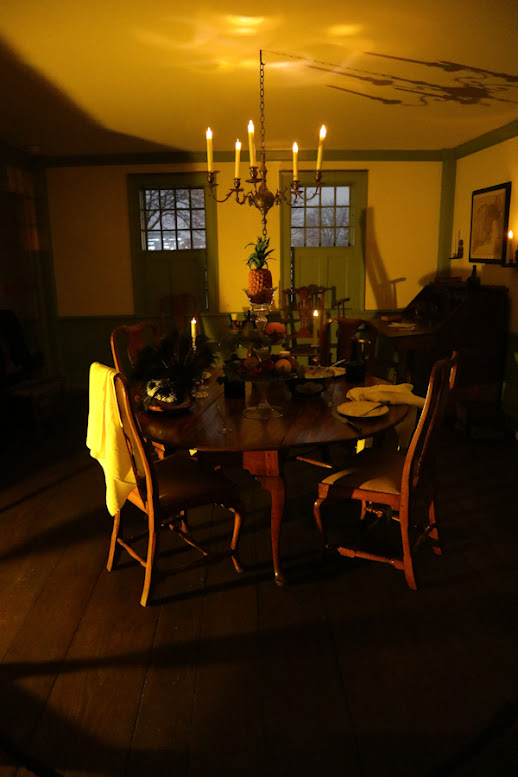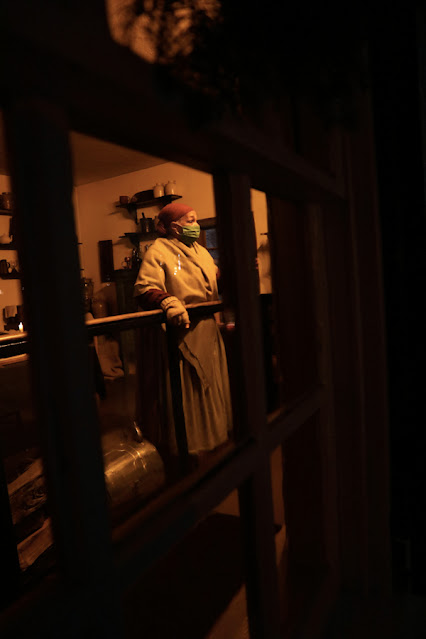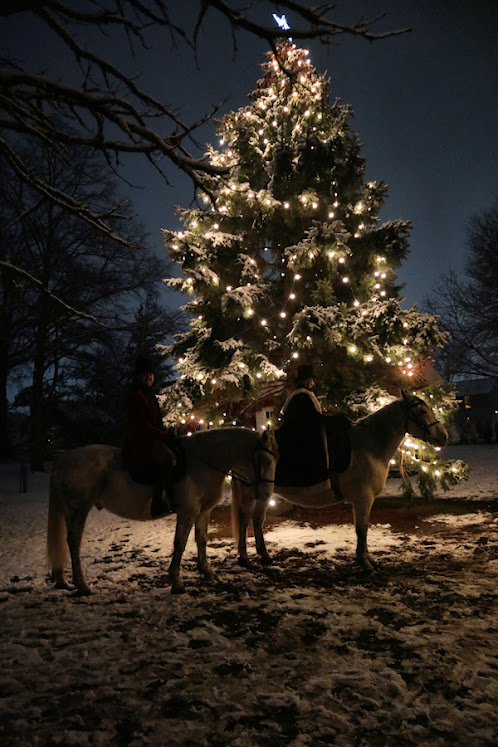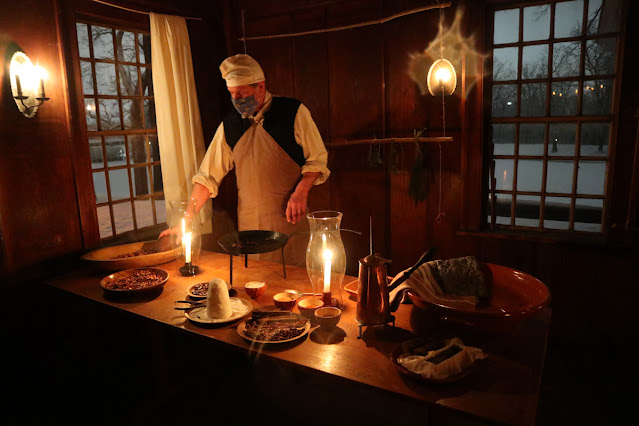Yeah...I'm at it again; taking any and every opportunity to wear my period clothing. And there are few better places to celebrate the Christmastide while wearing 18th century clothing than the colonial section of Greenfield Village, where my favorite 18th century houses are placed, making for awesome photos and even better night time atmosphere.
And in doing so we celebrated the Christmastide.
 |
| Where are you, Christmastide? |
So, before the pictures of our time at Greenfield Village's Holiday Nights, let's take a short history lesson that I think you'll enjoy:
Hmmm...Christmastide. Just what is the Christmastide? Is it different from Christmas time?
I took the time to do a bit of research to find out, and what I learned I found to be interesting.
Christmastide vs Christmas time:
The Christmastide is the period from Christmas Day to January 5th. It is similar to the word Christmas time, and their meanings can overlap, but Christmas time is usually used more generally to refer to the modern Christmas season, beginning at Thanksgiving in late November and includes the entire month of December.
However, for many, the Christmastide may sometimes begin on Christmas Eve when many families begin their celebrations. It ends on 12th night (January 5), which is included by most Christian faiths as being a part of the Holiday season as well. Christmastide is then followed on the sunset of the 5th of January (Twelfth Night) by the closely related day of Epiphany the following day (January 6th). Some also call this Epiphany tide. But the Twelve Days of Christmas terminate with Twelfth Night.
Here are your dates to follow:
December 24 - Christmas Eve - the evening before - or more recently, the entire day before Christmas Day, the festival commemorating the birth of Jesus.
The 1st day of Christmastide: December 25 - Christmas Day
The 2nd day of Christmastide: December 26 - St. Stephen's Day
The 3rd day of Christmastide: December 27 - Feast of St John the Apostle
The 4th day of Christmastide: December 28 - Feast of the Holy Innocents
The 5th day of Christmastide: December 29 - Feast of Saint Thomas Becket
The 6th day of Christmastide: December 30 - sixth day of Christmastide
The 7th day of Christmastide: December 31 - Saint Sylvester's Day / New Year's Eve
The 8th day of Christmastide: January 1 - Feast of the Circumcision of Christ / New Year's Day
The 9th day of Christmastide: January 2 - ninth day of Christmastide
The 10th day of Christmastide: January 3 - tenth day of Christmastide
The 11th day of Christmastide: January 4 - eleventh day of Christmastide
The 12th day of Christmastide: January 5 - Twelfth Night
And the 6th of January is Epiphany (Three Kings Day).
The well-known customs of the Christmas season - tide or time - include carol singing, gift giving, decorating, attending Nativity plays, church services, and eating special food and drink such as turkey, ham, pies (pumpkin, apple, mince meat), and Christmas cake, plus egg nog and wassail. Of course, the traditional examples of Christmas greetings include the phrase "Merry Christmas and a Happy New Year!" "Merry Christmas" has been used since at least 1534. A dated letter from bishop John Fisher to Henry VIII's chief minister Thomas Cromwell reveals as much. The English carol, "We Wish You a Merry Christmas," which was introduced in the 1500s, also uses the popular phrase. However, "Happy Christmas" in the modern times tends to lean toward England, while "Merry Christmas" seems to be the mainstay phrase here in America.
Only a few of the carols still sung today are specific to the celebration days during Christmastide, those of which occur after Christmas Day, such as Good King Wenceslas and The Wren in the Furze for December 26 - also known as St. Stephen's Day.
 |
| A few Wassailers heading toward the apple orchard, perhaps singing other Christmastide carols as they traipse through the snow. Yes, that is us... |
Then there is Deck the Hall and Gloucestershire Wassail was for New Year's celebrations, and We Three Kings for Epiphany (January 6th). And, of course, there is the most popular Christmastide carol of them all, The 12 Days of Christmas.
Wassailing was actually more popular on 12th Night than any other time during Christmastide. Aside from the Gloucestershire Wassail, they also sang The Apple Wassail, a traditional form of wassailing practiced in the cider orchards of southern England during the winter. On Twelfth Night, men would go with their wassail bowl into the orchard and go about the trees. Slices of bread or toast were laid at the roots and sometimes tied to branches. Cider was also poured over the tree roots. The ceremony is said to "bless" the trees to produce a good crop in the forthcoming season.
So, all dressed in my 1770-era clothing, I visited Greenfield Village during the Holiday Nights event once again this season. Holiday Nights celebrates 300 years of yuletide history, going as far back as the 1700s and up until the 1930s. Though not laid out in strict order, it is a sort of a historical Christmas timeline. As is my norm, I went on the last day it was occurring - December 28. In this way the most wonderful time of the year is extended, and yet, it is still technically a part of the season, for it is during the Christmastide. And we were also blessed with a light snowfall - the only time during Holiday Nights it snowed - on the night we went.
It was amazing!
 |
| As per usual for me, I head directly to my favorite house 1st thing: the home of Samuel and Anna Daggett, built by Samuel around 1750. |
As we made our way toward this favorite house of mine, I could hear historic presenter, Gigi, from the inside hollering towards us:
 |
"Come, weary travelers! Come in where 'tis warm!" I responded with, "Tis I, daughter, your father Samuel!" |
 |
| A fun little personal vignette! We made sure to have a quick sketch of us at the doorway. Thankfully, 'twas not a bitter night, aside from the snowfall. |
I've been to the Village for Holiday Nights in my period clothing when the temperatures were at 6 degrees - very bitter cold. On this night, however, it was only in the low 30s - a veritable heatwave in comparison.
Also along with Patty & I that night were our good living history friends, Amy and Jennifer.
 |
| Amy & Jennifer at the Daggett doorway. Oh! What fun we had! |
 |
| If you look closely, you can see me back in the shadows of the kitchen doorway, with the cut-up apples drying in the window behind me. |
 |
| From where I was standing I was able to capture a nice shot of Jennifer gazing at the fireplace and actually feeling a bit of its warmth. |
 |
| Also, while in the kitchen doorway, I captured the image of Suzette, another of the wonderful Village historic presenters. |
Down the street from the Daggett House we find "The Mansion House," as it was once known as before being moved to Greenfield Village. Merchant John Giddings had this house built around the same time as Samuel Daggett built his - around 1750.
 |
| The Giddings House is a wonderful example of colonial architecture for the more well-to-do of the mid-18th century. |
The servant girl greeted me as I knocked upon the door. It was New Year's, you see, and the annual Giddings grand party to welcome the new year was about to take place.  |
Inside we were greeted by the Mistress of the house.
 |
| Do you suppose this is Mehetable Giddings, John's wife? Naw...methinks it is Jane, normally seen at the Daggett House! |
 |
| The Giddings everyday parlor, also known as the sitting room, was set up beautifully with the rare wintertime treats.  |
And to the back of the house, where the kitchen lies, a chocolateer awaits us to show-n-tell us a bit about colonial chocolate:
Chocolate was initially a treat for the wealthy, but soon was available to the every man.
By the early 1770s, the demand for chocolate in the colonies resulted in the importation of over 320 tons of cocoa beans, which made drinking chocolate affordable to all classes of people and was available in most coffee houses, where colonists would gather to talk about politics and the news of the day.
 |
| Here is the Giddings' formal parlor, where much of the entertainment would take place. Imagine sitting around this table, enjoying your cup of chocolate... |
 |
| Here we have Jennifer & Amy about to head off to their next adventure. |
While we were inside watching the chocolateer, my wife spent her time in the snow...
 |
| ...building a snowman! Just a little one, mind you - - - |
 |
| This picture comes from my wife's phone, so she did not capture the people I was speaking to. As I moved away from the McGuffey Birthplace cabin, a young lady looked at me and said, "The British are coming!" Well, that started a pleasant conversation between us about early American history, including Paul Revere. |
As we moved along the lane, we stopped at a few other Christmas vignettes, including listening to a slave of the Carroll family at the Susquehanna Plantation House depicting 1860.
 |
| Actress Madelyn Porter portrays an 1860s slave at Christmastime, and tells her story of how she spends her holiday, particularly New Year's. It is gripping and very telling. |
 |
| Civil War reenactors tell of how the Union soldiers spent their time in the winter quarters. Generally, armies usually did not campaign in the winter months, with a few notable exceptions, and instead established more permanent camps from about December through March. |
All in good fun (there were no visitors inside the cabin during that moment).
Thinking outside the box may not always work for museums, but for this 1930s Christmas Tree lot, it definitely does. I say "thinking outside the box" because most places are too busy thinking about Santa, elves, reindeer, or even decorated trees.
 |
| Inside the Logan County Courthouse: built in 1840, it was one of the locations that lawyer Abraham Lincoln once practiced law before becoming president. |
 |
| As I stepped out of the Logan County Courthouse, this is the scene that lay before me. Lucky for me, the crowd of people surrounding the two riders had dissipated and I was able to capture a wonderful, almost magical moment. |
Thinking outside the box may not always work for museums, but for this 1930s Christmas Tree lot, it definitely does. I say "thinking outside the box" because most places are too busy thinking about Santa, elves, reindeer, or even decorated trees.
Who would've thought to show a Christmas Tree lot from the 1930s??
Greenfield Village would!
Toward the end of the evening, the temperatures were warming a bit, and the snow that was falling had turned into a light rain, and whatever was on the ground was becoming slush.
 |
| By the time of the Great Depression, Christmas Trees had already become a staple in nearly every home. |
 |
| The snow that fell earlier covered the trees wonderfully. They almost looked fake! |
 |
| Ha! Even the tree lot owner's automobile was parked nearby! This recreated 1930s tree lot was, to be honest, one of my favorite vignettes. I loved it! |
Toward the end of the evening, the temperatures were warming a bit, and the snow that was falling had turned into a light rain, and whatever was on the ground was becoming slush.
 |
| It was still cold enough for most of the snow to stick to the lamp pole wreathes. When creating Greenfield Village back in 1929, Henry Ford created a reproduction turn-of-the-20th century business district, a sort of "anytown USA" circa 1900, but that time of 121 years ago really comes forth at night more than the daytime. |
 |
| And one never knows when they'll see a friend strolling along the lane. |
It's not very often patrons can visit Greenfield Village during the evening darkness, or even when it snows, so I say we who went on this night of December 28 were doubly blessed, for a couple inches of the white stuff fell. Yes, the driving was a bit tricky for a while, but for this type of opportunity, I'll drive through a blizzard.
It was the perfect way to end the season for Greenfield Village.
I thank my wife for taking the greater majority of photos here with my camera. I also thank Jennifer Long for allowing me to use a few of her shots as well. The snow on the ground gave a luster of mid-day in the photographs.
Now, before you leave, I wanto jump back for a moment to when we spoke earlier about 12th Night and Epiphany, for I have a couple more interesting facts to tell about concerning the Holiday:
 |
| The distaff |
Did you know that plowing the ground and spinning on a spinning wheel had their own special days?
Traditionally, the first Monday after Epiphany was called Plow Monday because it was the day when men returned to their plows, or daily work, following the Christmastide. It was customary at this time for farm laborers to draw a plow through the village, soliciting money for a "plow light," which was kept burning in the parish church all year.
Sometimes falling on the same day as Plow Monday was Distaff Day (January 7). Like Plow Monday, Christmastide had ended, so this was when women were expected to return to their spinning. A distaff is the staff that women used for holding the flax or wool in spinning. Hence, the term "distaff" refers to women's work or the maternal side of the family.
This ancient verse captures the spirit of both long-forgotten special January days:
“Yule is come and Yule is gone
and we have feasted well;
so Jack must to his flail again
and Jenny to her wheel.”
By the way, I received a pipkin for Christmas from my wife this year.
What's a pipkin, you ask?
 |
| The piece of redware pottery you see here is a pipkin! But what is it used for? |
It's a cooking pot, and the stem is nothing but a hollow handle to make it easier to turn or move it while it sits over the fire. And my friend (and former Daggett presenter) wrote: "Foods that are acidic should not be cooked in an iron pot as they will react chemically with the iron and turn black. I learned this after making a batch of applesauce in an iron pot one summer at Daggett. Black applesauce tastes good but looks awful! The Pipkin is for cooking acidic foods. A thick stick can be inserted into the “snout” or hollow handle of the Pipkin to move it about as needed. (So) pipkins are also used when making jellies and preserves, although they were used anytime acidic foods were cooked. Most had three or four “legs” but not necessarily."
So where does one go to purchase a pipkin?
Try HERE
A-n-d---
One more thing before I go - -
for the first time ever I lit the candles on our Christmas Tree on Christmas Day itself!
 |
| Candlelit on Christmas Day. |
Normally I light them earlier in December due to its freshness (it's a real tree we cut down Thanksgiving weekend), but on Christmas Day we had two people over who had never seen a real candlelit Christmas Tree, so it was sort of an extra gift from me to them. But even more than that, my daughter, who no longer lives with us, requested to have them lit. This made me feel so good - sometimes one wonders if my kids like what I do or if they simply put up with me, so when my daughter requested I light the candles, I wasn't going to say "no." Sort of when my son Miles requests we eat dinners every-so-often by candle light during the non-season.
Yeah...makes me feel so good...
And with that - Merry Christmas and Happy New Year!!
Until next time, see you in time.
HERE'S how the colonials celebrated Christmas
HERE'S how the colonials celebrated New Year's
In this posting we learn more about the Daggett House itself, including its own history and how it came to be relocated to Greenfield Village, a more in-depth tour and study room by room, with virtual tour videos included as well from the presenters who work there, and even information on the kitchen garden. Sixty photos, most of which you may not have seen before.
And HERE is a "part 2" of the above posted link, with many more photos and much more information to help in bringing the Daggett Family to life in a way that has not been done before.
To learn how I turned a portion of my own home into a Daggett room, please click HERE
What many visitors don't realize is that inside these hallowed walls of history (Greenfield Village) there are three specific homesteads which are situated near each other, and the long past inhabitants of each of these historic 18th century houses played a role to some varying degree in the Revolutionary War.
This is their collective story.
The Giddings House
Revolutionary War and possible George Washington ties are within the hallowed walls of this beautiful stately colonial home.
Revolutionary War and possible George Washington ties are within the hallowed walls of this beautiful stately colonial home.
Through well-made historical movies centering on Abraham Lincoln, the Court House that sits inside Greenfield Village becomes even more alive.
And just look at the latest additions!
Preserving History
Henry Ford did more for preserving everyday life of the 18th and 19th centuries than anyone else! Here's proof.
Henry Ford did more for preserving everyday life of the 18th and 19th centuries than anyone else! Here's proof.
~ ~ ~ ~ ~ ~





1 comment:
Oh what fun! Scrolling back through, I was thinking "I love that, I love that, I. . ." So pretty much every picture you shared, I love it. I've been on a little back in time kick lately - especially with lighting. It feels "righter" Ha! Yes, I know that's not a word, but I do still use the electric so perhaps not completely "right" - yet. :-)
Merry Christmastide
Post a Comment